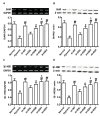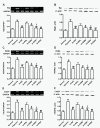Endoplasmic reticulum stress mediating downregulated StAR and 3-beta-HSD and low plasma testosterone caused by hypoxia is attenuated by CPU86017-RS and nifedipine
- PMID: 22226148
- PMCID: PMC3276427
- DOI: 10.1186/1423-0127-19-4
Endoplasmic reticulum stress mediating downregulated StAR and 3-beta-HSD and low plasma testosterone caused by hypoxia is attenuated by CPU86017-RS and nifedipine
Abstract
Background: Hypoxia exposure initiates low serum testosterone levels that could be attributed to downregulated androgen biosynthesizing genes such as StAR (steroidogenic acute regulatory protein) and 3-beta-HSD (3-beta-hydroxysteroid dehydrogenase) in the testis. It was hypothesized that these abnormalities in the testis by hypoxia are associated with oxidative stress and an increase in chaperones of endoplasmic reticulum stress (ER stress) and ER stress could be modulated by a reduction in calcium influx. Therefore, we verify that if an application of CPU86017-RS (simplified as RS, a derivative to berberine) could alleviate the ER stress and depressed gene expressions of StAR and 3-beta-HSD, and low plasma testosterone in hypoxic rats, these were compared with those of nifedipine.
Methods: Adult male Sprague-Dawley rats were randomly divided into control, hypoxia for 28 days, and hypoxia treated (mg/kg, p.o.) during the last 14 days with nifedipine (Nif, 10) and three doses of RS (20, 40, 80), and normal rats treated with RS isomer (80). Serum testosterone (T) and luteinizing hormone (LH) were measured. The testicular expressions of biomarkers including StAR, 3-beta-HSD, immunoglobulin heavy chain binding protein (Bip), double-strand RNA-activated protein kinase-like ER kinase (PERK) and pro-apoptotic transcription factor C/EBP homologous protein (CHOP) were measured.
Results: In hypoxic rats, serum testosterone levels decreased and mRNA and protein expressions of the testosterone biosynthesis related genes, StAR and 3-beta-HSD were downregulated. These changes were linked to an increase in oxidants and upregulated ER stress chaperones: Bip, PERK, CHOP and distorted histological structure of the seminiferous tubules in the testis. These abnormalities were attenuated significantly by CPU86017-RS and nifedipine.
Conclusion: Downregulated StAR and 3-beta-HSD significantly contribute to low testosterone in hypoxic rats and is associated with ER stress which mediates testis damage caused by oxygen deprivation. CPU86017-RS is potential in ameliorating hypoxia-induced testicular injuries, possibly by its calcium antagonist effects on the testis.
Figures





Similar articles
-
CPU86017-RS attenuate hypoxia-induced testicular dysfunction in mice by normalizing androgen biosynthesis genes and pro-inflammatory cytokines.Acta Pharmacol Sin. 2012 Apr;33(4):470-8. doi: 10.1038/aps.2011.175. Epub 2012 Mar 19. Acta Pharmacol Sin. 2012. PMID: 22426698 Free PMC article.
-
Apocynin and raisanberine alleviate intermittent hypoxia induced abnormal StAR and 3β-HSD and low testosterone by suppressing endoplasmic reticulum stress and activated p66Shc in rat testes.Reprod Toxicol. 2013 Apr;36:60-70. doi: 10.1016/j.reprotox.2012.12.002. Epub 2012 Dec 25. Reprod Toxicol. 2013. PMID: 23270704
-
Changes in testicular steroidogenic acute regulatory (STAR) protein, steroidogenic enzymes and testicular morphology associated with increased testosterone secretion in bulls receiving the luteinizing hormone releasing hormone agonist deslorelin.Domest Anim Endocrinol. 1998 Jul;15(4):227-38. doi: 10.1016/s0739-7240(98)00013-7. Domest Anim Endocrinol. 1998. PMID: 9673455
-
HC diet inhibited testosterone synthesis by activating endoplasmic reticulum stress in testicular Leydig cells.J Cell Mol Med. 2019 May;23(5):3140-3150. doi: 10.1111/jcmm.14143. Epub 2019 Mar 18. J Cell Mol Med. 2019. PMID: 30884106 Free PMC article.
-
Male hypogonadism induced by high fat diet and low dose streptozotocin is mediated by activated endoplasmic reticulum stress and IκBβ and attenuated by argirein and valsartan.Eur J Pharmacol. 2013 Aug 5;713(1-3):78-88. doi: 10.1016/j.ejphar.2013.04.030. Epub 2013 May 9. Eur J Pharmacol. 2013. PMID: 23665494
Cited by
-
Proteomic analysis reveals proteins and pathways associated with declined testosterone production in male obese mice after chronic high-altitude exposure.Front Endocrinol (Lausanne). 2022 Nov 30;13:1046901. doi: 10.3389/fendo.2022.1046901. eCollection 2022. Front Endocrinol (Lausanne). 2022. PMID: 36531490 Free PMC article.
-
Male fertility is reduced by chronic intermittent hypoxia mimicking sleep apnea in mice.Sleep. 2014 Nov 1;37(11):1757-65. doi: 10.5665/sleep.4166. Sleep. 2014. PMID: 25364071 Free PMC article.
-
Alterations of estrous cycle, 3β hydroxysteroid dehydrogenase activity and progesterone synthesis in female rats after exposure to hypobaric hypoxia.Sci Rep. 2020 Feb 26;10(1):3458. doi: 10.1038/s41598-020-60201-4. Sci Rep. 2020. PMID: 32103034 Free PMC article.
-
Hypoxia/oxidative stress alters the pharmacokinetics of CPU86017-RS through mitochondrial dysfunction and NADPH oxidase activation.Acta Pharmacol Sin. 2013 Dec;34(12):1575-84. doi: 10.1038/aps.2013.94. Epub 2013 Oct 14. Acta Pharmacol Sin. 2013. PMID: 24122013 Free PMC article.
-
Obstructive Sleep Apnea Is Associated With Low Testosterone Levels in Severely Obese Men.Front Endocrinol (Lausanne). 2021 Jul 26;12:622496. doi: 10.3389/fendo.2021.622496. eCollection 2021. Front Endocrinol (Lausanne). 2021. PMID: 34381420 Free PMC article.
References
Publication types
MeSH terms
Substances
LinkOut - more resources
Full Text Sources
Research Materials

